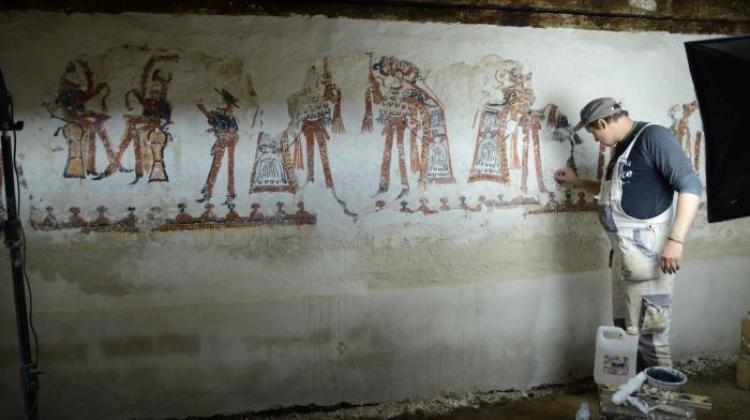Guatemala/ Polish archaeologists discovered several hundred artefacts in the holy lake of the Maya
Fragment of a face-shaped ceramic censer, evidence of religious rituals in the form of ceramic vessels - in total, Polish archaeologists discovered several hundred artefacts during underwater research in the lake Petén Itzá near the ancient Mayan capital Nojpetén in Guatemala.
Nojpetén was the capital city of the last of the ancient Maya groups that resisted the attacks of European conquerors for almost 200 years after their arrival in Central America. It was located on today`s Flores Island in the southern part of the vast Petén Itza Lake in Guatemala. This area was one of the places where Polish underwater archaeologists carried out research in August and September 2018. They reported their results in January.
"We have discovered more than 500 artefacts near the ancient Mayan capital, including objects sunk during religious rituals" - says the Polish team leader, archaeologist from the Jagiellonian University in Kraków, Magdalena Krzemień.
The place where the rituals took place was located north of the island, as evidenced by numerous finds. In one place, scientists saw three bowls placed one inside another. The top bowl contained fragments of burned wood and obsidian - glassy volcanic rock. The bowls rested on larger three-leg vessels. In one of them, archaeologists discovered an almost 20 cm long obsidian blade. "Its presence is clearly associated with ritual and sacrifice" - the researcher emphasises.
Krzemień believes that the discovery was made exactly in the place where the vessels had been originally deposited. They were partially buried under the bottom, so even the currents could not move them.
"It is a mystery how the Mayans were able to deposit the offering so that the vessels did not scatter over a larger surface. We suspect that they were dropped to the bottom in a net" - says underwater archaeologist Mateusz Popek from the Institute of Archeology, Nicolaus Copernicus University.
A bit further was a partly destroyed fragment of a censer shaped like a human head. The project leader says that very similar items have been discovered in onshore Maya temples.
"During some of the ceremonies the censers were deliberately broken. That was probably the case here" - she adds.
The researcher says that the lakes were an important element of the Maya`s holy landscape, because water had a special symbolic meaning for the members of this civilization - it was perceived as a medium, through which the dead would pass to the underworld.
Water reservoirs were also perceived as places closely related to Chaak - a rain god, responsible for rainfall, and consequently also crops. "That is why a large number of various kinds of sacrificial gifts ended up in water reservoirs over the centuries" - adds the project leader.
Archaeologists have determined the age of finds. They believe that the studied area was a place of worship from the Proto-Classic period (150 BC - 250 BC) to the late Classic period (600 - 800 BC).
The Maya resisted the conquistadors for a very long time. Nojpetén - the last independent fortress of the Maya - was captured in 1697 after a great battle. The Spaniards attacked the island on ships, from which they shot their weapons at the Maya.
Archaeologists also hoped to discover numerous items associated with this crucial moment during their research. The final battle between the residents of the capital city and the Spaniards took place on the west side of the island. While diving in this area, the Polish archaeologists only found a part of a mace, blunt weapon consisting of a heavy head on the end of a handle. They recovered a well-preserved stone head.
A little further north, in the area of the El Hospital island, archaeologists discovered of a large shell from the Caribbean Sea on the bottom, which indicates that the Maya had contacts with the inhabitants of the Caribbean Coast. "Such a shell could be used as a music instrument. It could also be connected to the elites or the symbolic sphere, because objects of this type were associated with births, rituals of maturation, sacrificial offerings, war, the underworld and death" - Krzemień says.
The project leader emphasizes that all artefacts were located on the surface of the lake bed - they did not even have to be excavated. "Considering the number of objects we discovered on the surface, we would probably find even more during excavations. Therefore, we plan to continue our research" - informs Krzemień.
You can follow the progress of the work on the project fanpage on Facebook.
PAP - Science in Poland, Szymon Zdziebłowski
szz/ zan/ kap/
tr. RL
Przed dodaniem komentarza prosimy o zapoznanie z Regulaminem forum serwisu Nauka w Polsce.
















